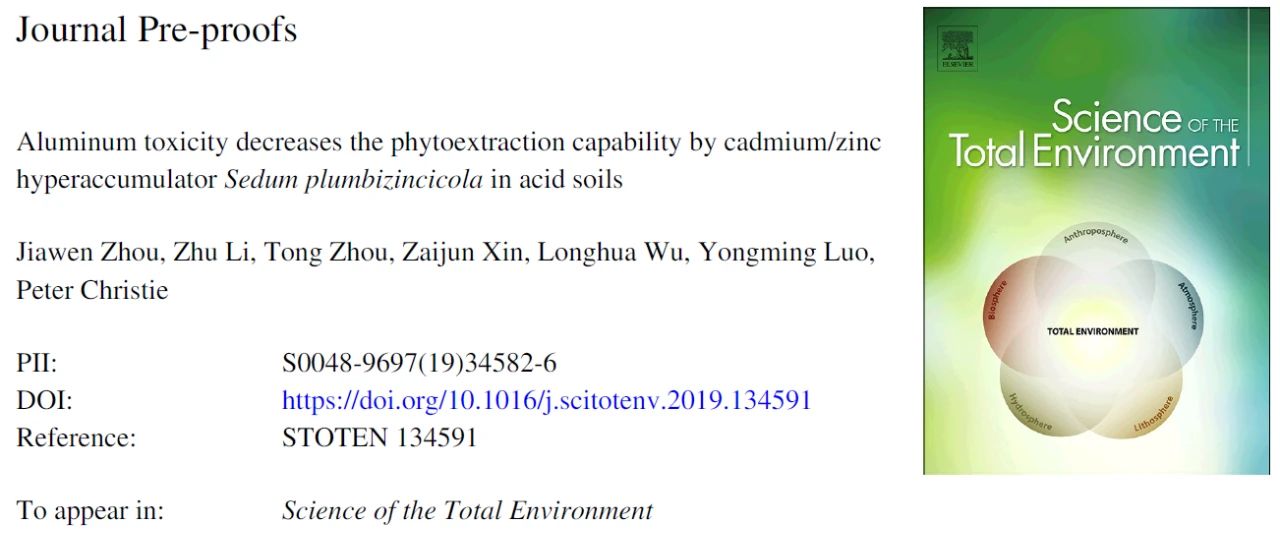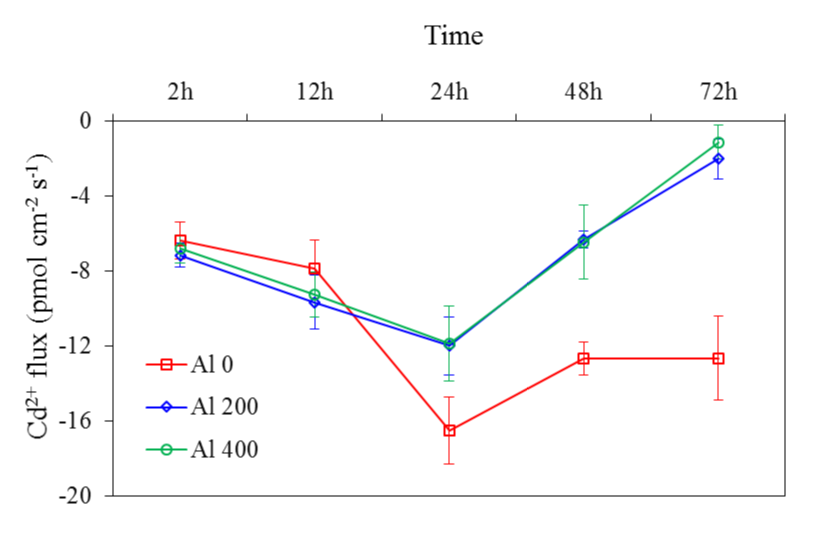NMT作为生命科学底层核心技术,是建立活体创新科研平台的必备技术。2005年~2020年,NMT已扎根中国15年。2020年,中国NMT销往瑞士苏黎世大学,正式打开欧洲市场。

研究使用平台:NMT重金属创新科研平台
期刊:Science of the Total Environment
主题:NMT验证铝毒削弱景天镉积累能力
标题:Aluminum toxicity decreases the phytoextraction capability by cadmium/zinc hyperaccumulator Sedum plumbizincicola in acid soils
影响因子:5.589
检测指标:Cd2+流速
检测样品:伴矿景天
Cd2+流实验处理方法:
伴矿景天幼苗在Al浓度为0、200、400μM,pH4的环境下处理2、12、24、48、72小时
Cd2+流实验测试液成份:
50 μM CdCl2, 0.1 mM CaCl2, MgCl2 and KCl, 1.0 mM NaCl, pH 4.00
作者:中科院南京土壤所吴龙华、李柱、周嘉文
中文摘要(谷歌机翻)
在酸性土壤中过量的铝(Al)或在重复的植物提取过程中由于酸化而释放的Al可能会损害超级蓄积剂的植物提取效率,但这通常被忽略。
在这里,我们首次在长期(7周)和短期(72小时)以及土壤条件下,通过水培试验研究了Al对镉(Cd)和锌(Zn)超积累性景天(Sedum plumbizincicola)的毒性。锅实验。在长期的水培试验中,即使在pH值为5.00的<100μMAl下(可溶性Al:8.74μM),也发现Al的可观察到的毒性作用,与无Al处理相比,它能降低芽Cd吸收39.3%。
非损伤微测技术显示,在48小时后用200μMAl在pH 4.00条件下处理后,根Cd2 +的流入被显着抑制。盆栽实验证实,Al毒性可抑制酸性土壤中植物的生长和金属吸收,可交换的Al为0.33 cmolc kg-1。Al胁迫引起的根部表面Cd吸附的减少可能是导致枝条Cd吸收减少的重要因素。
对金属化学形态的分析表明,铝的添加显着影响茎中Cd和Zn的化学形态,使它们的活动性降低,从而限制了Cd和Zn的转运。
在酸性土壤中和在反复的植物提取过程中,土壤中可能发生的铝毒害是限制使用超级蓄积剂从污染土壤中去除金属的效率的主要因素。

Net fluxes of Cd2+ at the root surface S. plumbizincicola under Al exposure in the short term. The error bars are SE, n = 8. Different letters indicate significant differences under different Al treatments at the same exposure time at P < 0.05.
英文摘要
Excessive aluminum (Al) in acid soils or Al released due to acidification during repeated phytoextraction might impair the phytoextraction efficiency of hyperaccumulators but this is often neglected.
Here, we investigate for the first time the toxicity of Al to the cadmium (Cd) and zinc (Zn) hyperaccumulator Sedum plumbizincicola with hydroponics experiments both in the long (7 weeks) and short terms (72 hours), and in soil conditions in a pot experiment. In the long-term hydroponics experiment, observable toxic effects of Al were found even at < 100 μM Al at pH 5.00 (soluble Al: 8.74 μM) which lowered shoot Cd uptake by 39.3% compared with the Al-free treatment.
Non-invasive Micro-test Technology shows that root Cd2+ influx was significantly inhibited after treatment with 200 μM Al at pH 4.00 after 48 hours. The pot experiment confirms that Al toxicity induced inhibition of plant growth and metal uptake in the acid soil with an exchangeable Al of 0.33 cmolc kg−1. Decreasing Cd adsorption at root surfaces induced by Al stress may be an important factor in declining shoot Cd uptake.
Analysis of the chemical forms of metals shows that Al addition significantly influenced the chemical forms of Cd and Zn in stems, made them less mobile and thus restrained Cd and Zn translocation.
Aluminum toxicity that potentially occurs in acid soils and in soils during repeated phytoextraction would be a primary factor limiting metal removal efficiency from contaminated soils using hyperaccumulators.
